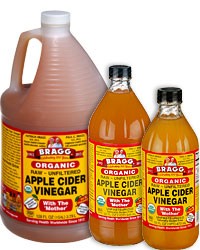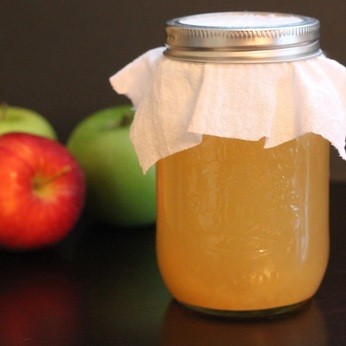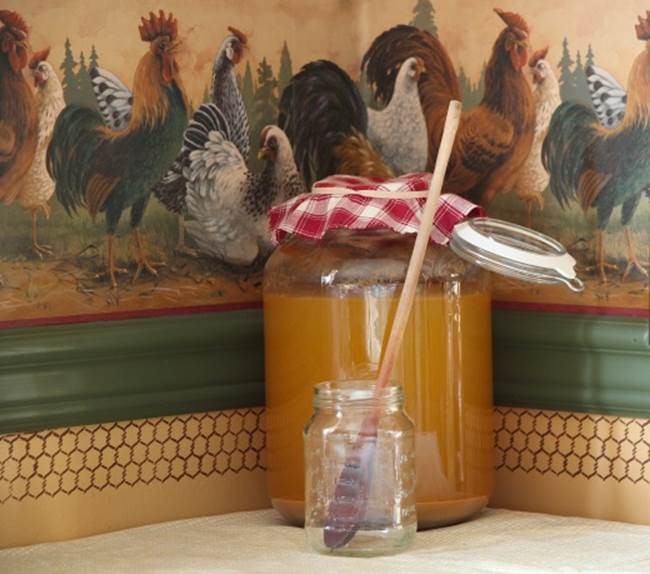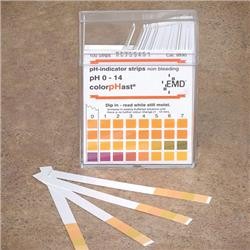Making Your Own Apple Cider Vinegar: Whys and Hows
It’s considered the panacea for just about every human ill from sore throats to incontinence to heart disease to aging. And it’s been touted as a cleaning agent and health and beauty product as well. Lots of people use it as a facial toner and hair rinse.
 So what is “it”? Apple Cider Vinegar! And I haven’t even mentioned its main role of simply being a FOOD
– a delicious vinegar and enhancement to many recipes. While you can buy some pretty good apple cider vinegars (Bragg’s is my favorite), making your own
has some distinct advantages. So let’s look at why we would want to make our own and then learn how!
So what is “it”? Apple Cider Vinegar! And I haven’t even mentioned its main role of simply being a FOOD
– a delicious vinegar and enhancement to many recipes. While you can buy some pretty good apple cider vinegars (Bragg’s is my favorite), making your own
has some distinct advantages. So let’s look at why we would want to make our own and then learn how!
Advantages to making your own? Simply put, this immune-boosting food is at its best when it’s freshest. And the body can use it more efficiently when it’s
undergone little to no processing.
That said, making it is easy. You start with raw, organic apple cider (available at farmers’ markets often, and generally at natural food stores). And then wait.
Try for the simplest means to an end—pour your apple cider into a
gallon-sized glass jar
. Never use a random metal container! To avoid corrosion from acid, you want a glass, wood, enamel, or stainless steel container. (Think corroded canning
rings from acidic foods….)
To speed the vinegaring process along you can add a packet or cake of yeast that’s specially cultivated for wine-making to the cider. But you’ll get a
perfectly fine product without this if you’re OK with waiting a little longer.
 Covering with cheesecloth isn’t the best idea because determined fruit flies can squeeze through. A cotton fabric covering is a better choice, secured with
a rubber band. Store the container out of direct sunlight and in an area where the temperature will be between 60-80°F.
Covering with cheesecloth isn’t the best idea because determined fruit flies can squeeze through. A cotton fabric covering is a better choice, secured with
a rubber band. Store the container out of direct sunlight and in an area where the temperature will be between 60-80°F.
 Stir your cider daily to aerate it and enable the bacteria to enjoy more oxygen. The bubbling you will see is the bacteria feeding on all that yummy sugar
content.
Stir your cider daily to aerate it and enable the bacteria to enjoy more oxygen. The bubbling you will see is the bacteria feeding on all that yummy sugar
content.
You will notice after a couple weeks (without added yeast) that you have made a nice apple wine (aka hard cider). You will want to continue on and allow
all of the alcohol to change into acetic acid. And, by the way, if you have a mother from another batch of vinegar you want to add, this is the time to
introduce that.
Once it becomes vinegar-ish, taste samples daily until the desired strength of the vinegar is reached.
Finally, because apple cider vinegar is antibacterial, antiviral and antifungal, you do not need to pasteurize it. To do so kills the mother – the host of
all the fresh enzymes- and essentially all of the beneficial properties of this vinegar. You don’t need to worry about the vinegar “going bad”, as it will
only mature and develop more potency and desirable smoothness of quality while allowing the mother to grow. If you had a mind to, you could create
“vintage” vinegars by letting them age in a cool dark place for years!
Store your vinegar in capped containers, preferably glass in a cool location out of direct sunlight. If you want more mother in your vinegar, you could put
it into the light, which causes the mother to grow.
 Regarding the acidity of homemade vinegars: Tthe sweeter your cider was to start with, the more acidic will be the resultant vinegar. So just be aware that
you don’t have a standardized acidity to your homemade product. If you want to measure the acidity of your vinegar there are kits available, but a simpler
way to determine if your vinegar is where you want it is to do a pH test with
inexpensive pH strips
. Apple cider vinegar is expected to have a pH of between 4.25-5.0, with the lower reading being the stronger acid content. For pickling, a vinegar should
not have a higher pH than 4.0, which is a level that will still inhibit bacterial formation and mold.
Regarding the acidity of homemade vinegars: Tthe sweeter your cider was to start with, the more acidic will be the resultant vinegar. So just be aware that
you don’t have a standardized acidity to your homemade product. If you want to measure the acidity of your vinegar there are kits available, but a simpler
way to determine if your vinegar is where you want it is to do a pH test with
inexpensive pH strips
. Apple cider vinegar is expected to have a pH of between 4.25-5.0, with the lower reading being the stronger acid content. For pickling, a vinegar should
not have a higher pH than 4.0, which is a level that will still inhibit bacterial formation and mold.
You can see how easy this process is. So why not make your own? Apple cider vinegar truly is a valuable asset to any medicinal arsenal and is delicious besides!
- www.bragg.com
- www.tickleyourpantry.com
- www.ultimatesurvivaltips.com
- www.shopbrodart.com
 Alice Osborne
Alice Osborne
Weekly Newsletter Contributor since 2006
Email the author! alice@dvo.com
